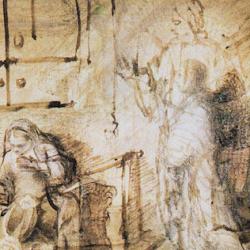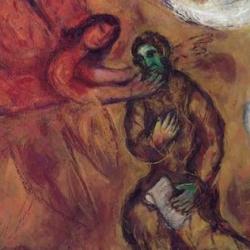One of the cruxes of the structure of Isaiah is the question of why Isaiah’s call and commission occurs in chapter 6 rather than, as in most of the prophets, at the beginning of the book. There is some resemblance between Isaiah and John in this respect, but John is commissioned as a prophet before the end of Revelation 1.
One of the reasons for this oddity, I think, is that Isaiah is constructed so that the opening section, chapters 1-12, structurally anticipates the whole. Both the opening chapters and the whole book have been outlined as heptamerous chiasms; I am suggesting that they are also matching chiasms. Below is an initial effort to make a case for this claim. It is inadequate largely because I am not yet as familiar with the book of Isaiah as a whole as I hope to be. But I think some of the connections are clear and remarkable enough to make my hypothesis a plausible one.
For chapters 1-12, I am relying on my own structural analysis, which I have written about before on this site. For the book as a whole, I am relying mainly on David Dorsey’s analysis, though with a minor adjustment.
1:1-31/1:1-12:6: The overall thrust of the first section of Isaiah is an indictment against Judah, though the whole section ends with a promise of exodus and restoration. That also, in general, characterizes the shape of chapter 1. Though much of chapter 1 is the indictment, there is the promise that the harlot city will be restored to righteousness. “Zion will be redeemed with justice, and her repentant ones with righteousness” (1:27), and this will especially involve a reversal of the abuse of the orphan and widow (1:23). The final section of 1-12 includes a promise of a Branch who is going to be filled with the Spirit in order to bring righteousness, justice, and faithfulness for the poor.
2:1-4:6/13:1-26:21: The nations first appear in Isaiah in 2:1-4, where they are streaming to Mount Zion, learning of the Lord’s ways, and beating their swords into ploughshares. The section unit of the book likewise focuses on the nations. Chapter 2 also includes a relentless account of all the high things that the Lord is going to topple; the lofty are going to be brought down. That is the message of the first oracle against the nations – the oracle against the king of Babylon, who exalted himself and then fell low. Philistines are first mentioned in 2:6, and there is an oracle against the Philistines in 14:28ff.
5:1-30/27:1-35:10: I have modified Dorsey’s structure at this point. He includes chapter 27 in the previous section, but in the light of my analysis of chapters 1-12, it seems best to include it here. When we do that, the links are very strong. Both sections begin with a parable about a vineyard, though the thrust of those two parables differs. In the first, Yahweh complains that His vineyard does not produce good fruit, while in chapter 27 He promises that His vineyard Jacob will take root, blossom, and fill the world with fruit (v. 6). In chapter 5, the vineyard parable is followed by a series of six woes, and the vineyard parable of chapter 27 is also followed by six woes (28:1; 29:1, 15; 30:1; 31:1; 33:1). The series of six woes in chapter 5 is interrupted by a narrative (chapters 6-9:7), and then a seventh woe follows in the following section (10:1) and then an additional woe against Assyria (10:5) that begins a new section. Similarly, the series of woes in chapters 27-35 is interrupted by a narrative, and two additional woes are pronounced in the following section (45:9-10), the final two woes in Isaiah. (Isaiah 55:1 uses the same Hebrew word, but not in the condemnatory way that it is used elsewhere).
6:1-9:7/36:1-39:8: The parallels between these sections are obvious. The call narrative of chapter 6 seems to stand outside the structure, but there are close links between chapters 6 and 40. Thus, the structure of these two sections is chiastic: Prophetic commission / prophet and king // prophet and king / prophetic commission.
9:8-10:4/40:1-48:22: The connections between these sections are not obvious or particularly numerous, but there are several. 9:8 begins an address, a “word,” to Jacob that falls on Israel, and the combination of Jacob and Israel is used repeatedly in chapters 40-48 (40:27; 41:8, 14; 42:24; 44:1, 5, 21, 23; 45:4; 46:3; 48:1, 12). After chapter 49, the combination appears only twice in Isaiah (49:5-6). In 9:10, the people of Ephraim and Samaria rebuild fallen altars and idolatrous temples with smooth stones and cedar, and in the idol polemics of chapters 40-48 Yahweh charges Israel with building and constructing false gods. Overall, the sections contrast. 9:8-10:4 repeatedly warns that the Lord’s anger is not spent, but chapter 40 begins with words of comfort, encouraging Zion to rejoice that her warfare is ended and her sins forgiven.
10:5-32/49:1-54:17: Chapter 10 is largely a woe against Assyria’s arrogance, but this haughtiness is embodied particularly in the arrogance of the “king of Assyria” (v. 12). Just as the Servant of Yahweh contrasts with the proud and ambitious king of Babylon (chapters 13-14), so the Servant of Yahweh is the true king who stands in contrast to the king of Assyria.
10:33-12:6/55:1-66:24: In both of these sections, the work of Yahweh and His servant brings about a restoration of the whole creation. The Branch of chapter 11 points to the anointed Servant of chapter 61. The imagery of peace among the animals appears in both chapter 11 and 65:25. Chapter 12 celebrates the Lord’s opening of the springs of salvation (v. 3), which are alluded to in 58:11. “Salvation,” used three times in 12:2-3 is used another nine times in the final section. Because of the root of Jesse, there will be glorious rest (11:10, and the Lord raises the question of the place of His rest in 66:1. The Branch will be a standard to assemble the nations and gather the dispersed of Israel (11:12), a gathering that Yahweh promises near the end of the book (66:18).










